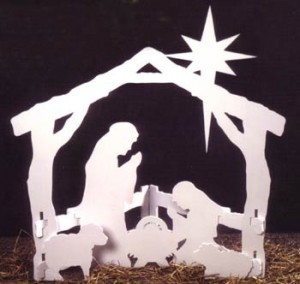Are Nativity Displays Constitutional?

By Monica Miller
Although the First Amendment forbids the government from establishing religion, once again this holiday season, cities and counties across the country will be displaying nativity scenes to celebrate the birth of Jesus Christ on government property. Nativity scenes (also known as crèches) have no place on government property. Indeed, the Supreme Court has held that stand-alone religious holiday displays violate the Establishment Clause. That much is clear.
Unfortunately, governments can place such displays on their property if there are sufficient “secular holiday symbols” nearby, such as snowmen, Santa Claus, and reindeer. According to the U.S. Supreme Court, there must be enough of these in the display to detract “from the crèche’s religious message.” The Court justified this rule on an erroneous assumption–that a “reasonable observer” would not perceive a crèche prominently affixed on government property, surrounded only by a few not-exclusively-Christian Christmas decorations, as endorsing religion. Adding “secular” decorations, all of which relate to the holiday surrounding the birth of a religious figure, hardly negates the government’s obvious endorsement of Christianity.
The Supreme Court first addressed the issue of public holiday displays in 1984 in Lynch v. Donnelly. The Court held that Pawtucket did not violate the Establishment Clause by including a city-owned crèche in a holiday display in a private park. The display also included “a Santa Claus house, reindeer pulling Santa’s sleigh, candy-striped poles, a Christmas tree, carolers, cut-out figures representing such characters as a clown, an elephant, and a teddy bear, hundreds of colored lights,” and a large banner that read “SEASONS GREETINGS.” The Court found that the inclusion of a single religious symbol, the crèche, did not “taint” the entire display.
Justice Sandra Day O’Connor concurred but wrote separately to offer what later became the “endorsement of religion” standard: “What is crucial is that a government practice not have the effect of communicating a message of government endorsement or disapproval of religion.” Justice O’Connor famously recognized that endorsement of religion sends “a message to non-adherents that they are outsiders, not full members of the political community, and an accompanying message to adherents that they are insiders, favored members of the political community.”
Five years later, the Supreme Court adopted the endorsement test in County of Allegheny v. ACLU of Greater Pittsburgh. This was the second and most recent Supreme Court decision involving the constitutionality of holiday displays. In Allegheny, two displays were challenged. The first consisted of a crèche display inside a courthouse, sponsored by a Catholic church. The other involved an elaborate display featuring a 45-foot Christmas tree and an 18-foot menorah, placed outside the City-County Building. The Court held that the crèche was unconstitutional but not the menorah.
The Court found that “unlike in Lynch, nothing in the context of the display detracts from the crèche’s religious message.” Because the crèche was situated on the most prominent staircase in the courthouse, no passerby could view it without receiving “an unmistakable message that it supports and promotes the Christian praise to God that is the crèche’s religious message.” A disclaimer sign identifying the private sponsor did not change this conclusion.
Although Santa Claus figures and other Christmas decorations were present elsewhere in the courthouse, there were none on the staircase. In distinguishing the case from Lynch the Court observed: “The Lynch display comprised a series of figures and objects, each group of which had its own focal point.” In contrast, the crèche in Allegheny sat alone in the “main” and “most beautiful part” of the “building that is the seat of county government.”
The menorah presented a “closer constitutional question,” but the majority ultimately concluded it was permissible. Unlike the crèche in Lynch, which was owned by the city, neither Allegheny County nor Pittsburgh owned the crèche or menorah. The Court found relevant the fact that “a Christmas tree and a sign saluting liberty” surrounded the menorah. The Court believed the tree to be a secular symbol, and the sign proclaiming liberty to “diminish the possibility that the tree and the menorah will be interpreted as a dual endorsement of Christianity and Judaism.”
Many governments today add “secular” Christmas decorations to their crèche displays solely to meet the minimal requirements set forth in these cases rather than to genuinely celebrate the “cultural significance” of a national holiday, as in Lynch.
Others have decided they would rather display the crèche alone, ignoring the clear command of Lynch and Allegheny. To get around these cases, they rely on the “open forum” doctrine derived from free speech jurisprudence. The theory is that in a traditional public forum, where private individuals have fundamental free speech rights, a crèche donated by a private individual is private, rather than government speech. Of course, by creating such a forum, the government must remain viewpoint neutral and cannot deny access to other speakers based on the content of their speech. Hence, a humanist cannot be precluded from putting up a display promoting humanism simply because of its message.
The Appignani Humanist Legal Center has already received multiple complaints about crèches on government property. If you are offended by a crèche (or menorah or other holiday display) on government property, please let us know. If the display includes other “secular” decorations, take note of what they are and where they are.
Monica Miller is a legal consultant for the Appignani Humanist Legal Center of the American Humanist Association.
